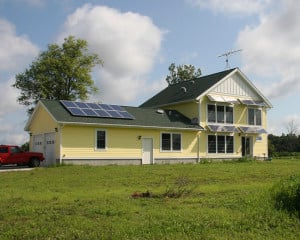We’ve been designing homes around the position of the sun since we started taking shelter millennia ago. The era of tract housing and subdivisions saw us bucking that trend, but today you’d be hard pressed to find any architect or designer worth their salt who would ignore which direction the house is facing in relation to the sun. Ignoring how the sun’s path affects the home will most likely result in comfort issues, but even more importantly, it also wastes a commodity that is plentiful and free! Natural light is the least expensive, yet often considered the best way to light a space. The most rigorous green building standard in place today, the Living Building Challenge emphasizes how important it is by requiring that every living space within a building have natural light as part of a healthy indoor environment. Of course, designing for the sun not only gives us natural light, but also maximizes our potential for solar energy, whether through passive or active systems (photovoltaic). Appropriately sized south-facing windows and overhangs that keep out the harsher summer sun while welcoming the winter sun (a passive strategy) can reduce our utility bills while increasing our thermal comfort (win-win). Photovoltaic systems are easily added to a building after the fact, so long as the building was originally designed with them in mind (plan ahead, if you can!)
In the photo below solar awnings are shading the south-facing windows in the summer. while harnessing solar energy year round. In the winter, the sun is low enough that is shines through the windows under the awnings warming up the space inside. Year around the solar panels are harnessing the solar energy year round. It’s a win, win, win!

But enough of the technical stuff…there is an amazing amount of fun we can have with natural light as a design element. I once had a client ask me to place a window so that on a particular day of the year, the resultant sunbeam that came through shone on a particular spot in the house. That location triggered a fond memory that she wanted to be reminded of every year on that day. How cool is that? Yes, there are difficulties and it takes some thought, but it is possible.
The location of the sun is predictable, and we can calculate where it will be and when. We’ve been doing this for thousands of years. I got a great reminder of this last year on the vernal equinox (June 21st) when I witnessed about 24 minutes of awesome at Chichen Itza. (See the body of the snake made from the shadow of the pyramid? Imagine seeing it appear and cheering for the sun along with 30,000 others from around the world.)

So, let’s get creative with the sun. Ask us about windows, skylights, sun tunnels, and light shelves; and watch as we start getting really excited about what might be possible.
